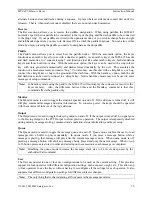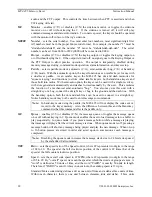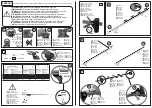
MFJ-495 Memory Keyer
Instruction Manual
©
2001-2009 MFJ Enterprises, Inc.
23
Note:
The
Ç
(UP),
È
(DOWN),
Å
(LEFT), and
Æ
(RIGHT) keys are referred to as the Arrow keys
in this manual.
Setup Commands
Press the tilde “~” key to enter command mode and the keyer responds with “CO” (dah-di-dah-dit dah-
dah-dah). Enter a setup command. If the command is invalid then the keyer will send an error character
(di-di-di-di-di-di-di-dit) and return the keyer to normal mode. If the user wishes to re-attempt modifying
features using command mode, he must re-enter command mode by pressing “~” key again. If you enter
the command mode accidentally, press ESC key to exit. At any time, press ENTER to accept and exit or
press ESC to cancel and exit. Alternately, pressing CTRL+Key to directly enter the command mode; that
is, CTRL+S is the same as “~S”. To perform this action, press and hold the CTRL key, press a letter key
B to Z, and then release the CTRL key. Refer to the appendix “Setup Commands” on page 48 for a table
of these commands.
B#
B
ank – selects the current memory bank, where # is A, B, C or D. Each memory bank has
eight message blocks of 256 characters each, except the last block. Alternately, press F9 to
select bank A, F10 for bank B, F11 for bank C, and F12 for bank D.
C#
C
haracter space – increases the inter-character space with # standard intra-character spaces,
where # is a single digit from 0 to 9. This allows the normally three-unit long inter-character
space up to 12 units long. Note the inter-character space is always at least four units shorter
than the word space. Therefore, you might have to increase the word spacing before
adjusting the character space.
Press LEFT or DOWN to decrease or press RIGHT or UP to increase the character spacing,
or enter one digit 0 to 9 to set the character spacing. Press ENTER to accept and exit, or
press ESC to cancel and exit.
D
D
ecrement – decrements the serial number by one, effectively canceling the automatic
increment applied when last played from a message. The decrement function accommodates
re-sending the last serial number, as might be needed when a repeat of a contest exchange is
requested, or canceling the exchange with a station that proved to be a “dupe”. The unit will
echo a "D" (dah-di-dit) for every number that is decrement. Decrement serial number 0001
rolls over to 9999, because the number 0000 is not used.
E##
E
dit – allows the operator to append onto or edit an existing message memory, where the first
# is the message number 1 to 8 and the second # is the bank A to D. The keyer will display
your message to the last word. You can then enter more text or erase existing words, just like
the procedure when loading a message.
F##
F
arnsworth – uses to enable Farnsworth mode and spacing. Farnsworth spacing adds more
time between characters to slow down the overall sending speed. The advantage of this is
that, by hearing the characters sent at a faster speed, you learn to recognize each character by
its distinctive rhythm, rather than by trying to "count dits." This greatly assists you in
copying Morse code at higher speeds. The Farnsworth speed, however, must be higher than
the overall speed. Setting ## to 00 or less than or equal to the overall speed will disable
Farnsworth mode.
Press LEFT or DOWN to decrease or press RIGHT or UP to increase the speed, or enter two
digits 10 to 99 to set the Farnsworth speed or 00 to turn off Farnsworth mode. Press ENTER
to accept and exit, or press ESC to cancel and exit
















































